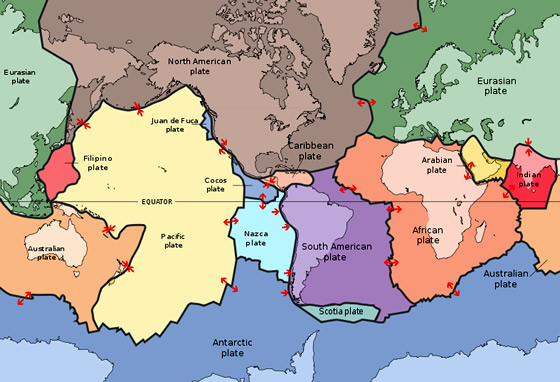On the human timescale most of the Earth seems passive and unchanging. But in some places -California, Italy, Turkey and Japan, for example -the Earth's crust is active and liable to move, producing earthquakes or volcanic eruptions.
These and other dynamic areas lie on the major earthquake belts, most of which run along the middle of the ocean basins, although some are situated on the edges of oceans (around the Pacific Ocean, for instance) or pass across continental land masses (as along the Alpine-Himalayan belt).
It is this observation that there are several relatively well-defined dynamic zones in the Earth's crust which forms the basis of plate tectonics.
According to this theory, the crust consists of several large, rigid plates and the movements of the plates produce the Earth's major structural features, such as mountain ranges, mid-ocean ridges, ocean trenches and large faults.
 Stable areas with few or no earthquakes or active volcanoes lie in the middle of a plate, whereas active areas - where major structures are constantly being destroyed or created - are situated along the plate boundaries.
Stable areas with few or no earthquakes or active volcanoes lie in the middle of a plate, whereas active areas - where major structures are constantly being destroyed or created - are situated along the plate boundaries.
The positions and sizes of the crustal plates can be determined by studying the paths of seismic waves (shock waves produced by earthquakes) that travel around and through the Earth. Such studies have also made it possible to estimate the thickness of the plates.
Geologists have found that seismic waves tend to slow down and become less intense between about 100 and 400km below the surface. From this observation they suggest that the solid lithosphere (which consists of the Earth's outermost layer, the crust, and the top part of the mantle, the layer below the crust) "floats" on a less rigid layer (the asthenosphere) which, because it is flexible, allows vertical and horizontal movements of the rigid lithospheric plates.
By collating the findings from various seismological studies, geologists have discovered that the lithosphere is divided into a relatively small number of plates. Most of them are very large -covering millions of square kilometers - but are less than about 100km thick.
Movement of Tectonic Plates
The landforms, earthquake activity and volcanism that characterize plate boundaries are caused by movements of the plates. There are three principal motions: the plates may move apart, collide or slide past each other.
Plate separation entails the formation of new lithosphere between the plates involved. This process occurs at constructive plate boundaries along the crests of mid-ocean ridges (and is therefore termed sea-floor spreading), where material from the mantle wells up to create the new crust.
Plate collision, on the other hand, necessitates the destruction of lithosphere at a plate boundary. Ocean trenches mark destructive plate boundaries, and at these sites the lithosphere of one plate is thrust beneath an overriding plate and reabsorbed into the mantle; this process is called subduction.
Ultimately, continued subduction of an ocean basin can lead to the complete disappearance of the basin and collision of the continents at its edges. In such collisions, mountain belts may be formed as the continents push against each other and force upwards the intervening land - as occurred when India collided with Asia some 50 million years ago, creating the Himalayas.
After a continental collision, the momentum of the plates is initially absorbed by thickening and over-thrusting of the continental crust. But there is a limit to which this process can occur and, because the continental crust is too buoyant to be subducted, the momentum must be dissipated in other ways - by the sideways movements of small plates that form within the newly-created mountain belt or by a more general, probably worldwide, change in the boundaries and movements of the plates.
The other principal type of plate movement occurs when plates slide past each other (at what are called sites of transform faulting) which, unlike the first two types of movement, involves neither creation nor destruction of the intervening lithosphere. Often major faults, such as the San Andreas fault in California, mark these plate boundaries (which are called conservative plate boundaries).
Tectonic Plate Movement Speed
Most of our knowledge about the very slow rates of plate movements has come from studies of the Earth's magnetic field. In the past the magnetic field has repeatedly reversed direction (a phenomenon called polarity reversal). A record of the changing magnetic field has been preserved in the permanent "fossil" magnetism of the basalt rocks that form the ocean floor.
Around sites of sea-floor spreading, bands of rocks with normal polarity alternate with bands having a reversed polarity. By dating these different bands, the speed of spreading can be deduced. Using this method it has been found that the speeds of plate separation vary from about 9mm a year in the northern Atlantic Ocean to 90mm a year in the Pacific Ocean.
From these determinations of separation speeds geologists have calculated the relative motions of plates that are moving together or sliding past each other. They have thus determined the movements of almost all the plates on the surface of the Earth.